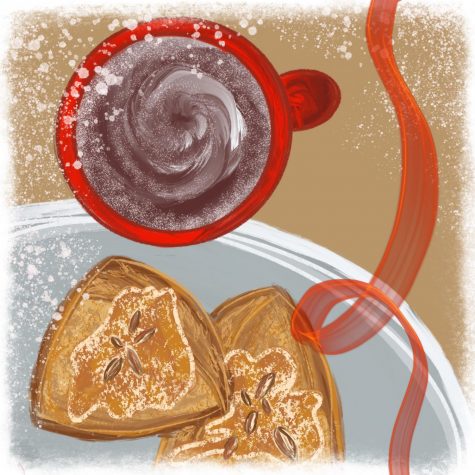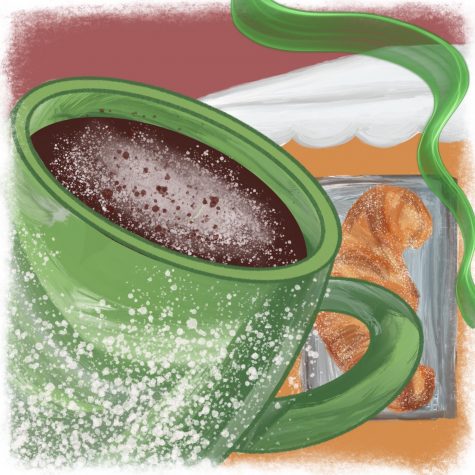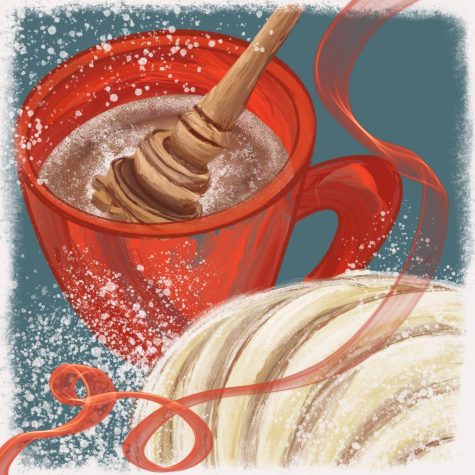A diverse array of hot chocolate and its best friends
December 9, 2020
The holidays are all about celebration, and any celebration is incomplete without many different kinds of food. However, there is one cozy beverage that is essential to the festive season —hot chocolate. Here is a breakdown of different versions of the iconic holiday drink and what foods they pair best with.
Instant hot cocoa
Combine a packet of Swiss Miss hot cocoa powder with hot water and voila! A piping hot mug of hot cocoa is now ready to be enjoyed while sitting in a fuzzy blanket while watching How the Grinch Stole Christmas or Elf.

Swiss Miss was first launched in 1961 by Charles Sanna, whose father managed a dairy company. Sanna used cocoa powder and nonfat milk powder, which was inexpensive and had a long shelf life, to develop the first instant cocoa that could be made with hot water instead of milk.
Instant hot cocoa is also easy to make with cocoa powder, sugar and hot milk or a combination of hot water and milk powder. Dutch-processed cocoa powder is favorable due to its dark color and intense flavor, but any cocoa powder can provide a comforting drink for the holidays.
Hot cocoa is perfect to have while watching a classic holiday movie, so why not pair it with some white chocolate peppermint popcorn? The sweet and salty popcorn has a pronounced flavor that pairs beautifully with the creamy chocolate. The snack, which simply requires coating popcorn with white chocolate and crushed peppermint candies, is quick and easy to make just like instant hot cocoa, so the time strayed away from the Buddy the elf or the Grinch will not be for long.
Vegan hot chocolate

Vegan hot chocolate, despite containing less calories and being dairy-free, is just as sweet and delicious as any other hot
chocolate. A non-dairy milk, like almond or oat milk, is used along with cocoa powder and a vegan sweetener like organic sugar or stevia. Vanilla extract, which usually brings out the flavor of the chocolate, can be replaced with peppermint extract or coffee extract for a fun twist. The drink can also be garnished with coconut whipped cream or vegan chocolate shavings.
There are plenty of vegan instant versions of hot chocolate, too. Both Ghirardelli and Starbucks’ regular hot cocoa mixes are dairy-free, consisting of cocoa powder, sugar and vegan chocolate. In fact, chocolate is inherently plant-based because it is made from cacao beans, chocolate liquor, sugar and cocoa butter, which is simply the fat that is extracted from the cocoa bean.
A sweet pastry like a vegan scone with a caramel drizzle is this hot chocolate’s best friend. Vegan hot chocolate is not quite as decadent as the regular drink, so a scone with a rich caramel topping made primarily from dates, nut butter, dairy-free milk and coconut oil pairs wonderfully. A quintessential pair, caramel and chocolate can never go wrong.
Parisian hot chocolate: le chocolat chaud
In 1615, Anne of Austria, Louis XIII’s wife, introduced chocolate to France from the Americas and hot chocolate later became a habit at the court of Versailles, the home of French royalty. However, it was not until the Industrial Revolution in the 18th century that the delicacy became more accessible for common people across Europe.

Many cafés and tearooms in France are now known for their le chocolat chaud, the most notable places including Les Deux Magots, Café de Flore and Angelina, all three of which are located in Paris. Chocolate itself is the most important ingredient in traditional French-style hot chocolate, as no cocoa powder is used. Dark chocolate that contains around 70 percent cocoa is mixed with milk, cream or a combination of both. French-style hot chocolate also has notably less sugar than its American counterpart, hot cocoa. The addition of espresso powder further intensifies the chocolate flavor, resulting in a beverage that is extremely rich and decadent.
Another French delicacy like le chocolat chaud, the croissant is a pastry that is made by laminating sheets of butter between dough to create hundreds of layers, resulting in a pastry that is buttery and rich yet still light and flaky. A croissant filled with fresh fruit and whipped cream has the tang and sweetness to balance the rich and bitter flavors of French-style hot chocolate, making it the perfect accompaniment.
El chocolate caliente: Mexican spiced hot chocolate

Mexican chocolate has a slightly grainy and rustic texture and is traditionally sold in circular and hexagonal tablillas, or tablets. To create Mexican spiced hot chocolate, or el chocolate caliente, the chocolate is heated with whole milk, sugar and vanilla extract. A wooden whisk called a molinillo is traditionally used to froth the beverage. The tool is placed between the palms of the hands, where it is rolled back and forth quickly for up to 30 minutes to create a creamy and airy texture. Characteristic Mexican spices such as cinnamon, ground chile de árbol, a type of Mexican chili pepper and cayenne pepper differentiate the drink from other versions of hot chocolate.
Conchas, a type of pan dulce, or Mexican sweet bread, is the ideal food to dip into el chocolate caliente. These pastries are recognized by their shell-shaped sugary topping, which mainly consists of vegetable shortening, powdered sugar and flour. Although the topping is traditionally white, bright pink and yellow are also common. Conchas can also be spiced with cinnamon, so the similar flavors between the sweet bread and this spiced chocolate make them perfect complements.
Whether you take 30 seconds to mix a packet of Swiss Miss hot cocoa with hot water or take 30 minutes to froth Mexican hot chocolate with a molinillo, hot chocolate will forever be an iconic drink during the holidays.



























































